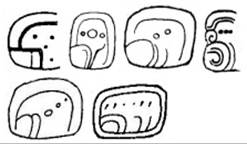![]()

![]()
![]()
K&H.p86.#6 K&L.p25.#5 TOK.p13.r1.c1 BMM9.p12.r6.c2
TAN TAN TAHN TAN

![]()
![]()
![]()
JM.p226.#3 = 25EMC.pdfp46.#7.2 JM.p226.#4 = 25EMC.pdfp46.#732 JM.p228.#1 JM.p226.#5 = 25EMC.pdfp46.#7.1
TAN TAN TAN:na TAN


SJ.p314.2 MC.p165.r7.c1
TAN
![]()
BMM9.p12.r6.c3
TAN
![]()
WagnerEtAl-TNNT
PAL TS C2
<K’IN:ni>.<TAHN:na>
· Distinguish from:
o One of the variants of TZOLK’IN day-name MEN

o One of the variants of jo
![]()
· Features:
o Boulder outline.
o 3 non-touching dots, middle dot slightly larger.
o Quarter arc in bottom left (optionally reinforced ceiling and right wall.
o 2 additional slightly curved arcs to the right (curvature = right vertical half of circle).
· BMM9.p12.r6.c3 gives an unusual variant with a circle with bold edge, and cross hatching right up to the bold circumference.
· 25EMC gives this as “in the centre of”:
o Wichmann-TGotHPG.p327.l+5: The lexical morphemes [TAHN LAM] that enter into the half-period glyph are the adverb tan with the approximate meaning ‘half’ and the verb lam ‘to diminish’.
o Wichmann-TGotHPG.p328.l-3: The form tan, more precisely ta[h]n, is attested in the lowland languages with meanings ranging from ‘chest’ to ‘front’ and ‘face’. For Ch’orti’ (Wisdom 1950b) it is attested as tahn ‘inner side or surface of, center, interior, concave side of’.
· Has the transferred meaning of “chest” (K&L.p25: TAN; K&H.p116):
o Asserted in WagnerEtAl-TNNT.p5.pdfp5.para4: k’in+ta[h]n+bolay? “Sun-Chest-‘Feline'” (published 2015; bolay è k’ew established in ZenderEtAl-SSw, published in 2016).
o Are we sure it is the transferred meaning rather than that this is the original meaning, with half, centre, middle coming later?
· The morpheme tahn occurs in many compounds, diverse in meaning from a Western point of view:
o cha tahn winik: title of rulers subordinate to Calakmul.
o juun tahn: beloved.
o Toktahn: an earlier capital of the Baakel polity, before the move to PAL (see Martin-AMP.p130.para3.l+7).
o tahn ch’een: a city.
o tahn ha’: the plaza of a city.
o tahn lam: half period (half exhausted).